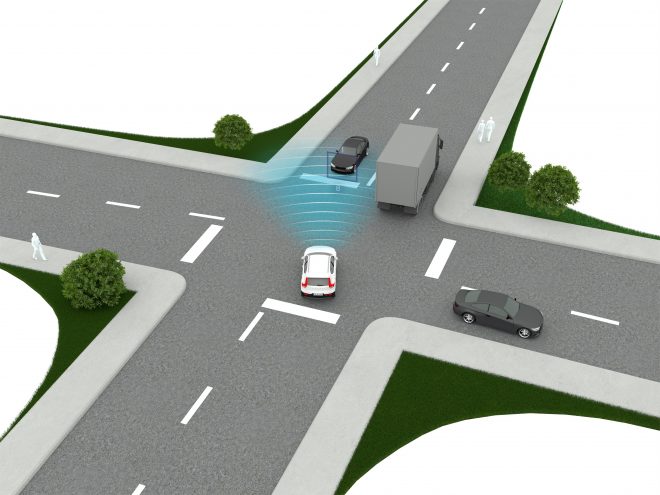
Air Brakes: A Commercial Vehicle’s Key to Safety
In the U.S., air brakes are used to stop and control large trucks and trailers. Air brakes are a critical component of safe commercial vehicle operation, but drivers must know some important things about them.
Trucks, buses, and other commercial vehicles use “air” to slow or stop.
This is how it works: When the driver steps on the brake pedal, brake fluid (which is stored in a tank) is pushed from the master cylinder through the hoses and into each wheel’s air chamber where it mixes with the air. The braking system then uses the pressure created by this mixture of fluid and air to slow or stop a vehicle. Air brakes are more precise than hydraulic systems because they allow drivers to use gradual stopping power rather than an abrupt application of brakes. There is also no loss in braking power due to leaks, which can occur in hydraulic systems and when turning a corner or going up a hill. Air brakes have been around for more than 100 years and are still used today because they are simple, reliable, and effective.
Air Brakes Help Prevent Accidents
On the highway, with its heavy commercial traffic and narrow lanes, accidents involving trucks can be catastrophic. These accidents often result in serious injury and even death. In fact, truck accidents cause more than 4,000 deaths and 110,000 injuries every year in the United States. It is important to remember that you have rights when you are involved in a trucking wreck. You can file a personal injury lawsuit against another driver’s negligence if it is necessary. Truck accidents are also common in California. To learn more on how a lawyer can help, Visit the MVP Accident Attorneys in Irvine CA.
Many commercial trucks are required by law to have air brakes designed to decrease the likelihood of accidents involving large commercial trucks. In fact, there were a significant number of truck accidents in the past few years, but thanks to modern technology and proper legislation, these incidents are now being resolved. Air brakes help prevent these truck accidents from occurring since they offer many benefits when compared to hydraulic brakes.
The purpose of brakes on commercial vehicles is to slow down or stop the vehicle from moving while parked or at a stationary position. Commercial vehicles include trucks, heavy vehicles, buses, and trains.
There are two types of brakes – the drum type and the disc type. Both of these brake types use friction to stop or slow down a moving vehicle. The drum type is for trucks or much bigger vehicles, while the disc type is mostly for cars.
The Air Brake System
The air brake system is for the drum-type brake system. It needs higher pressure to activate the brake system effectively for vehicles that carry heavy loads such as for product delivery, construction supplies, and people transportation.
There are several components to an air brake system. The components are as follows:
- Air Compressor: It is a device that takes air and pressurized air into a storage tank.
- Compressor Governor: It is a device that controls the production of compressed air into the storage tanks.
- Air Reservoir Tanks: It is a storage tank that holds the needed pressurized air for the braking system.
- Drain Valves: These are release valves used to drain the pressurized air in the storage tank when not in use.
- Foot Valve or Brake Pedal: It is a mechanism of a vehicle that the driver depresses with the foot to release the air to the drum brakes.
- Brake Chambers: It is a cylindrical container that houses an adjuster.
- Push Rod: It is a piston that connects to the brake chamber. When depressed or released, it opens or closes the brake pads.
- Slack Adjuster: It is an arm that connects the pushrod to the S-cam. It adjusts the distance between the brake plates.
- Brake S-Cam: The S-shaped cam is a device that pushes the brakes’ shoes apart or towards the brake drum.
- Brake Shoe: Steel mechanism that comes into friction contact with the brake drum when the pedal is depressed.
- Return Spring: It is a mechanism to pull the brake shoes on the original position.
Recommended read: Thousands of Lives Saved With Better Truck Safety Technology
The Advantages and Disadvantages of An Air Brake System
There are advantages to using the air-brake system. Unlike in a hydraulic brake system, a minor leak on an air brake system does not result in brake failures, which is crucial for commercial vehicles’ safety on the road because of their heavy load. Moreover, air couplings are easy to attach or detach. Moreover, an air brake system has a higher reliability rate than the hydraulic brake system. Plus, the air supply is unlimited and always available.
On the other hand, there are some disadvantages to the use of an air brake system. One is the moisture build-up due to the compressed air. It should use an air dryer to prevent moisture, which has an extra component and maintenance costs.
Another is that commercial drivers have to study the use of the air-brake system as it is difficult to operate. Some countries need further permits to operate vehicles that use the air brake system as it needs specific knowledge and skills.
Final Thought
Large vehicles, such as the commercial type, may pose a danger during crashes that can cause catastrophic damage to life and property. The air brake system can be designed to be fail-safe as it has a storage compressed air tank.
Have an air practice test to check if you have fully understood the air brake system. Full understanding of how the air brake system works will help commercial drivers pass the licensure test and most importantly, increase safety on the roads.
Author Brett Sachs
Brett Sachs, partner & principal attorney at MVP Accident Attorneys, graduated from Michigan State University College of Law with Cum Laude Honors and worked for an insurance defense firm before starting his practice. Brett has evaluated thousands of personal injury cases and has helped his clients receive the justice they deserve. https://themvp.com/attorneys/brett-sachs/









